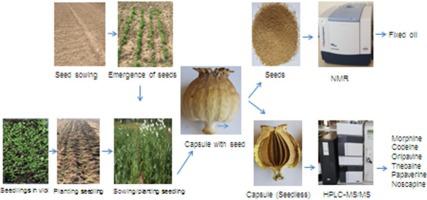Journal of Applied Research on Medicinal and Aromatic Plants ( IF 3.9 ) Pub Date : 2021-01-07 , DOI: 10.1016/j.jarmap.2020.100290 Nimet Kara , Hasan Baydar

|
Turkey is the world’s leading country in legal poppy cultivation and morphine production. As with other producing countries, the poppy is traditionally cultivated in Turkey through the sowing of seeds during the autumn. However, if the seasonal rains are insufficient and irregular, this can lead to problems with germination and emergence. In this research, the option of solving these problems by using seedlings in production, instead of seeds, was investigated. The study compares the yield and quality performance of the two production methods, planting seedlings and direct seed sowing in the poppy cultivar ‘Ofis-4’. Field experiments were conducted on three sowing/planting dates, namely October fifteenth, November first, and November fifteenth, during the growing seasons of 2017/18 and 2018/19 in the semi-arid ecological conditions of the southwestern region of Turkey. The plants produced by seedling transplantation and by sowing were compared in terms of the yields of seeds and capsules along with yield-related traits and the contents of seed-fixed oil and capsule opium alkaloids. The planting seedling method was seen to be an average of one week faster than the sowing method. In terms of the sowing/planting time delays in the autumn season, it was also observed that the ripening difference between both propagation methods started to narrow. If the general averages are considered, the highest capsule and seed yields were obtained from planting seedling on October fifteenth, the first planting date, in both years. Since the planting dates were late, the capsule and seed yield decreased while it was found that the contents of capsule alkaloids, except morphine and codeine, were not significantly affected by the production method and sowing/planting dates. On the other hand, the direct sowing method and first sowing date produced the highest morphine (0.53 and 0.58 %, respectively) and codeine (0.101 and 0.126 %, respectively) contents. It was therefore concluded that the seedling planting method can be recommended as an alternative to the direct sowing method traditionally applied in poppy production for the achieving of high capsule and seed yields.
中文翻译:

在不同的日期播种机幼苗中的罂粟的产率和质量秋季的影响(罂粟L.)
土耳其是合法罂粟种植和吗啡生产方面的世界领先国家。与其他生产国一样,罂粟在土耳其传统上是通过秋季播种来种植的。但是,如果季节性降雨不足且不规则,则可能导致发芽和出苗问题。在这项研究中,研究了通过在生产中使用幼苗代替种子来解决这些问题的选择。该研究比较了两种生产方法的产量和质量表现,即在罂粟品种“ Ofis-4”中播种和直接播种。在三个播种日期(即10月15日,11月1日和11月15日)进行了田间试验,在土耳其西南地区半干旱生态环境中的2017/18和2018/19生长季节。比较了幼苗移植和播种产生的植物的种子和荚膜产量,与产量相关的性状以及种子固定油和荚膜鸦片生物碱的含量。播种方法比播种方法平均快了一周。在秋季播种/播种时间延迟方面,还发现两种繁殖方法之间的成熟差异开始缩小。如果考虑共同平均值,则在两个年份的第一个播种日期即10月15日,从播种秧苗中获得最高的荚膜和种子产量。由于播种时间很晚,荚膜和种子产量下降,而发现除吗啡和可待因外,胶囊生物碱的含量不受生产方法和播种/播种日期的影响。另一方面,直接播种法和第一次播种的吗啡含量最高(分别为0.53和0.58%)和可待因(分别为0.101和0.126%)。因此得出的结论是,可以建议使用幼苗种植方法来替代罂粟生产中传统使用的直接播种方法,以实现高荚膜和高种子产量。直接播种法和第一次播种期产生的吗啡含量最高(分别为0.53%和0.58%)和可待因含量(分别为0.101%和0.126%)。因此得出的结论是,可以建议使用幼苗种植方法来替代罂粟生产中传统使用的直接播种方法,以实现高荚膜和高种子产量。直接播种法和第一次播种产生的吗啡含量最高(分别为0.53%和0.58%)和可待因含量(分别为0.101%和0.126%)。因此得出的结论是,可以建议使用幼苗种植方法来替代罂粟生产中传统使用的直接播种方法,以实现高荚膜和高种子产量。



























 京公网安备 11010802027423号
京公网安备 11010802027423号